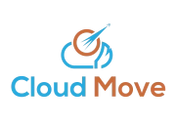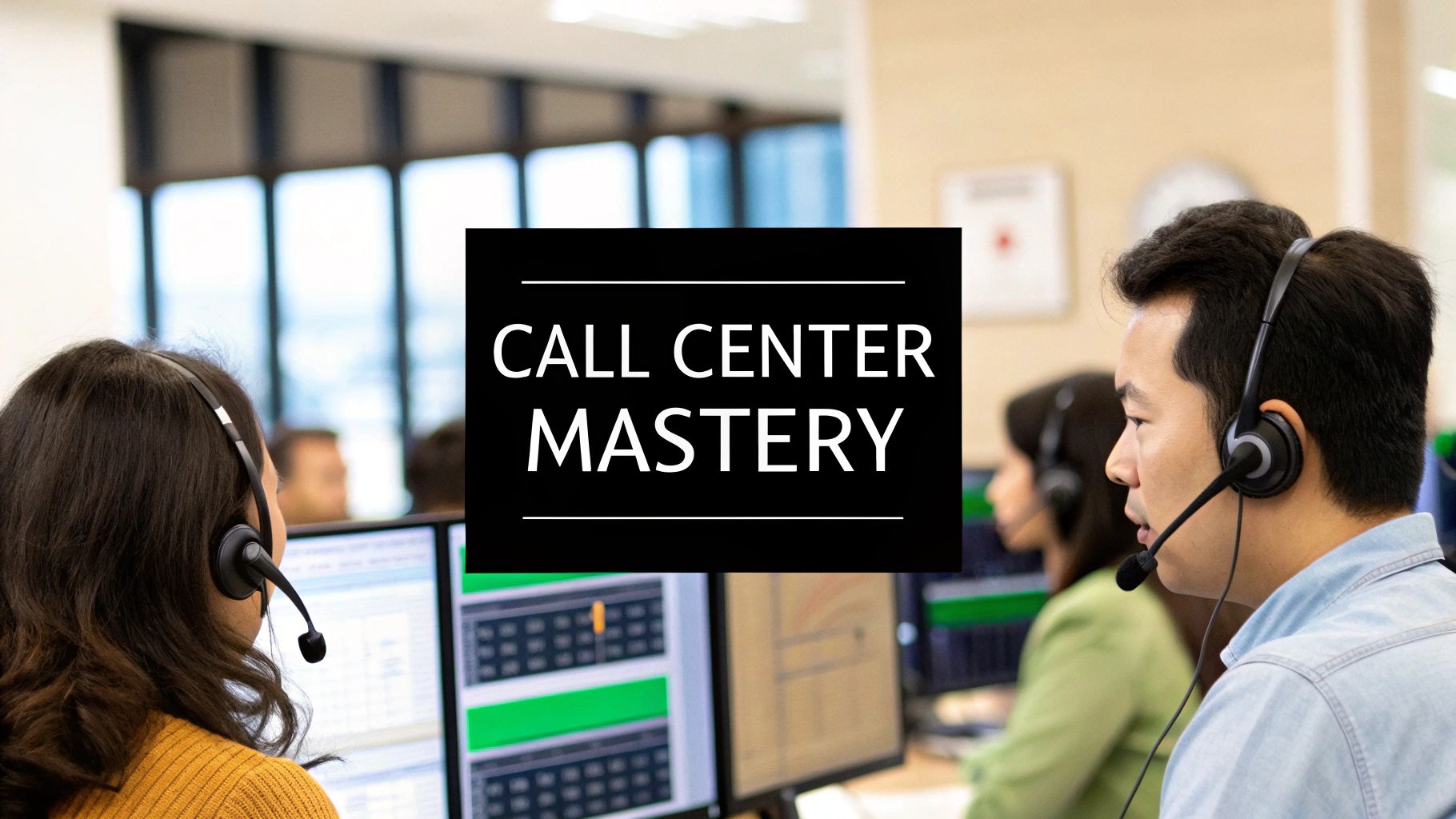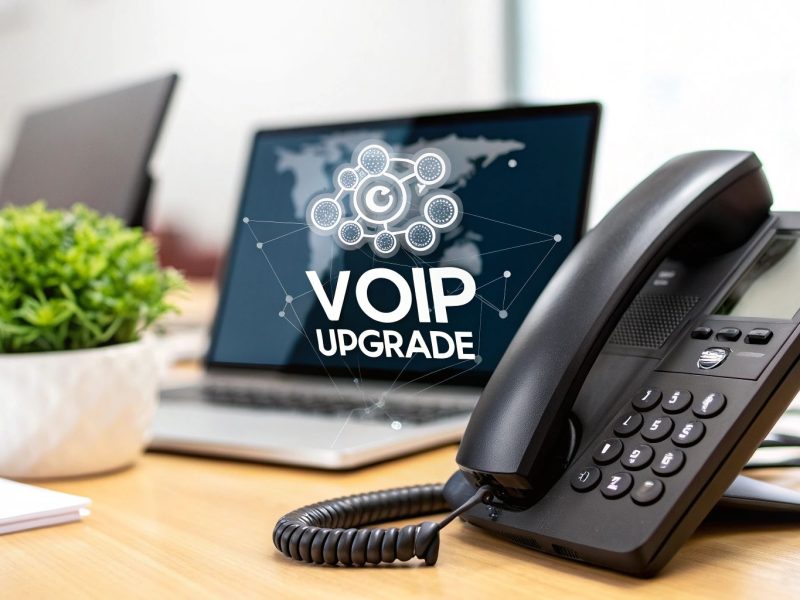Discovering What Call Center Optimization Really Means
Let's face it: when most people hear "call center optimization," they imagine agents scrambling to answer calls faster or squeezing more staff into each shift. But true optimization is far more nuanced. It's about fine-tuning every aspect of your operation, like a conductor leading an orchestra, where each instrument contributes to a harmonious and powerful performance.
Think of a perfectly synchronized team of cyclists in a race. Each rider plays a crucial role, drafting off each other, communicating effectively, and working together to reach the finish line. In a call center, that "finish line" is delivering exceptional customer service, efficiently and effectively. This isn't achieved through band-aid solutions, but through strategically planned and implemented improvements across the entire operation.
This screenshot from the Wikipedia page for "Call centre" illustrates the interconnectedness of a typical call center environment:
The image highlights the complex web of roles within a call center – agents, supervisors, tech support, and more. It underscores why optimization is so vital for managing this complexity and ensuring a smooth, efficient operation. When these interconnected roles work in harmony, it translates to a better customer experience and ultimately, a more successful business.
The Middle East and Africa call center market provides a compelling example of optimization's growing importance. Valued at $6,309.68 million in 2024, this market is projected to expand at a CAGR of 12.2% from 2025 to 2033. This growth is driven by technological advancements and strategic partnerships aimed at improving customer engagement and operational efficiency. You can learn more about this expanding market here. This rapid growth highlights the critical need for a proactive and strategic approach to call center management in the region.
Imagine a call center investing in a powerful new CRM system but failing to properly train its agents on how to use it. The technology, despite its potential, becomes a source of frustration and inefficiency. This illustrates a key principle: true call center optimization isn't about simply acquiring the latest technology. It's about a holistic strategy that considers people, processes, and technology working together seamlessly. This integrated approach is what distinguishes fleeting improvements from lasting, transformative change, unlocking your call center's full potential and driving sustained success.
Metrics That Actually Drive Results (Not Just Dashboards)
Optimizing a call center isn't about quickly shuffling calls like a deck of cards. It's about creating a well-oiled machine where every part works in harmony. And just like a chef carefully measures ingredients to create a delicious dish, measuring the right metrics is the key to call center success. It's tempting to focus on simple metrics like average handle time (AHT). A lower AHT might look good on paper, but pushing agents to rush calls can leave customers feeling like they’re on a conveyor belt, ultimately damaging satisfaction.
Imagine a customer calling with a tangled tech issue. An agent laser-focused on AHT might rush through the explanation, leaving the customer more confused than before. This leads to repeat calls, wasted time, and frustrated customers. It’s like giving someone a quick, messy recipe instead of walking them through it step-by-step.
Beyond The Basics: Metrics That Matter
Instead of fixating on single metrics, we need a balanced scorecard, considering various interconnected factors. It’s about looking at the whole picture, not just one piece of the puzzle. For a more detailed look at these key performance indicators, check out our guide on contact center KPIs. Platforms like Salesforce offer robust call center software with features that emphasize a more holistic approach.
The screenshot shows not just call tracking, but also features like knowledge management and service integration. This helps agents truly understand customer needs and contributes to more meaningful metrics beyond basic call stats. It's like giving your chef the best tools and ingredients – they’re then equipped to create something truly special.
So, which metrics truly move the needle? Think first call resolution (FCR) and customer satisfaction (CSAT). These are the North Stars guiding us towards customer loyalty and business growth. FCR measures how often an agent solves the issue on the first try. CSAT captures the customer’s overall experience. High FCR and CSAT scores? That's a recipe for happy, returning customers. Just as important are agent engagement and employee retention. Happy agents mean happy customers, leading to better business outcomes. This focus on both customer and employee well-being is the bedrock of effective optimization.
To help visualize the difference between a traditional approach and a more optimized one, let’s take a look at the following comparison:
Essential Call Center Metrics Comparison
| Metric Category | Traditional Approach | Optimized Approach | Business Impact |
|---|---|---|---|
| Efficiency | Average Handle Time (AHT) | First Call Resolution (FCR) | Reduced operational costs, improved customer satisfaction |
| Customer Satisfaction | Basic surveys | CSAT, NPS (Net Promoter Score) | Increased customer loyalty, positive word-of-mouth |
| Agent Performance | Call volume | Agent engagement, employee retention | Improved service quality, reduced agent turnover |
This table highlights how shifting our focus from simply handling calls quickly (AHT) to resolving issues effectively on the first try (FCR) can drastically impact both customer satisfaction and business costs. Similarly, delving deeper into customer sentiment through metrics like NPS provides a richer understanding of customer loyalty.
Connecting Metrics To Business Value
Simply tracking metrics is like having a pantry full of ingredients but no recipe. We need to understand how they relate to the bigger picture—how they translate into tangible business value. It’s about connecting the dots between great customer service and real business results. This requires communicating these insights clearly to stakeholders. Think of a financial analyst explaining market data to investors—they don’t just present numbers, they tell a story about what those numbers mean.
Similarly, we need to frame call center metrics in a way that resonates with business leaders, demonstrating how improved customer service contributes to revenue growth, cost reduction, and competitive advantage. This involves moving from reactive measurements to predictive indicators – focusing on the factors that drive future success. It's not just about looking at what happened, but about understanding what will happen.
Technology That Actually Enhances Human Performance
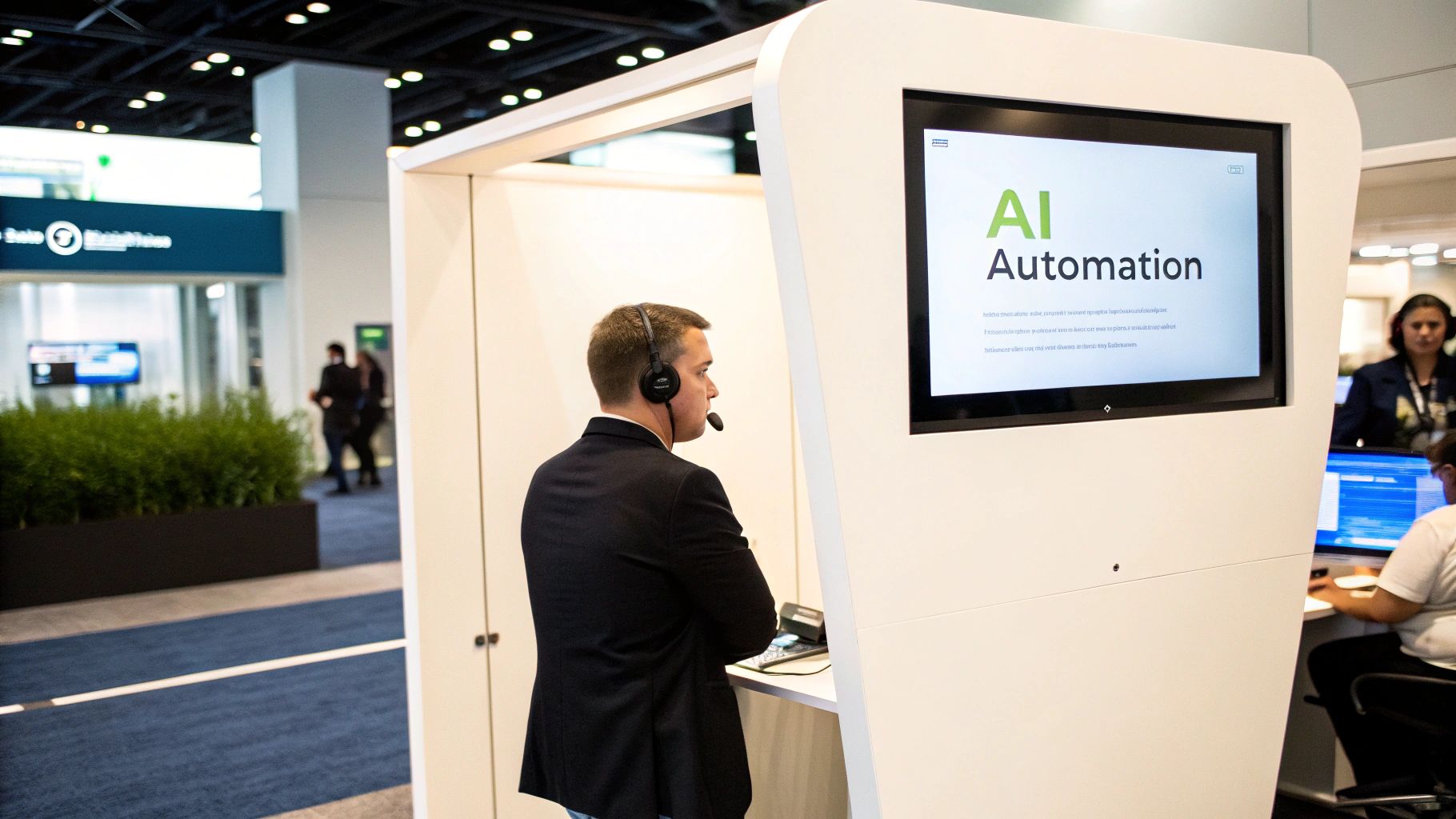
This screenshot from the Genesys platform shows what a modern agent desktop looks like. Notice how everything is brought together in one place—different communication channels, customer information, everything. This unified view lets agents handle customer interactions more efficiently, leading to faster and more personalized service.
It’s like having all the essential tools neatly arranged within easy reach. No more scrambling for information across multiple systems! This streamlined approach frees up agents to focus on what truly matters: the customer.
The real power of technology in call center optimization isn't about replacing humans with robots. It's about giving agents the tools they need to truly shine. Think of a skilled craftsperson: they can do amazing work with basic hand tools. But imagine what they could create with precision instruments!
Technology empowers agents to perform at their best, transforming them from simple call-takers into architects of exceptional customer experiences. And this, of course, leads to happier, more loyal customers.
Empowering Agents With Intelligent Systems
One way technology boosts human performance is through intelligent routing. Imagine a customer calls in with a complicated billing issue. Instead of being transferred from department to department, intelligent routing analyzes their question and sends them directly to the agent best suited to solve their specific problem. This reduces customer frustration and speeds up resolution times.
Another powerful tool is real-time analytics. Picture a dashboard that gives agents instant feedback during a call. It might suggest helpful resources or highlight potential customer pain points. This real-time assistance allows agents to anticipate customer needs and deliver a truly personalized experience. You might be interested in exploring more about contact center software.
Choosing the Right Tech for Call Center Optimization
The Middle East and Africa (MEA) region has seen a surge in the adoption of call center platforms, reflecting a growing focus on optimizing customer service. As of 2022, the MEA call center platforms market was valued at $2,060.74 million, and it's projected to reach $5,517.27 million by 2030. This growth is fueled by advancements in technology like cloud-based solutions, which allow for more efficient customer interactions. Learn more about this trend here.
However, simply investing in technology isn’t enough; choosing the right technology is crucial. It's not about chasing the newest gadgets but about selecting solutions that address your specific challenges. This requires a careful evaluation process, focusing on features that directly impact your key performance indicators (KPIs). For instance, if improving First Call Resolution (FCR) is your goal, look for technologies that give agents easy access to knowledge bases and customer history.
Implementing Technology Smoothly
Implementing new technology can feel disruptive, like rearranging furniture in a busy house. But with the right approach, it doesn't have to be. Successful implementation requires a strategic plan that minimizes disruptions to daily operations.
This can involve phased rollouts, comprehensive training programs, and ongoing agent support. Think of it like renovating a restaurant: you wouldn't shut down the entire place at once. Instead, you'd work on one section at a time, ensuring customers can still enjoy their meals. Similarly, a phased approach to technology implementation allows your call center to maintain service levels while agents adapt to the new systems. This strategic, incremental approach ensures a smooth transition and sets the stage for success.
Building Teams That Actually Want To Stay And Perform
Let's be honest: call center optimization is impossible with a revolving door of agents. Forget surface-level perks; building a high-performing, stable team demands understanding what truly motivates agents. Think of it like nurturing a garden: the right soil, sunlight, and care are essential for growth. Similarly, your agents need the right environment to flourish – one that cultivates their skills, offers growth, and instills a sense of purpose.
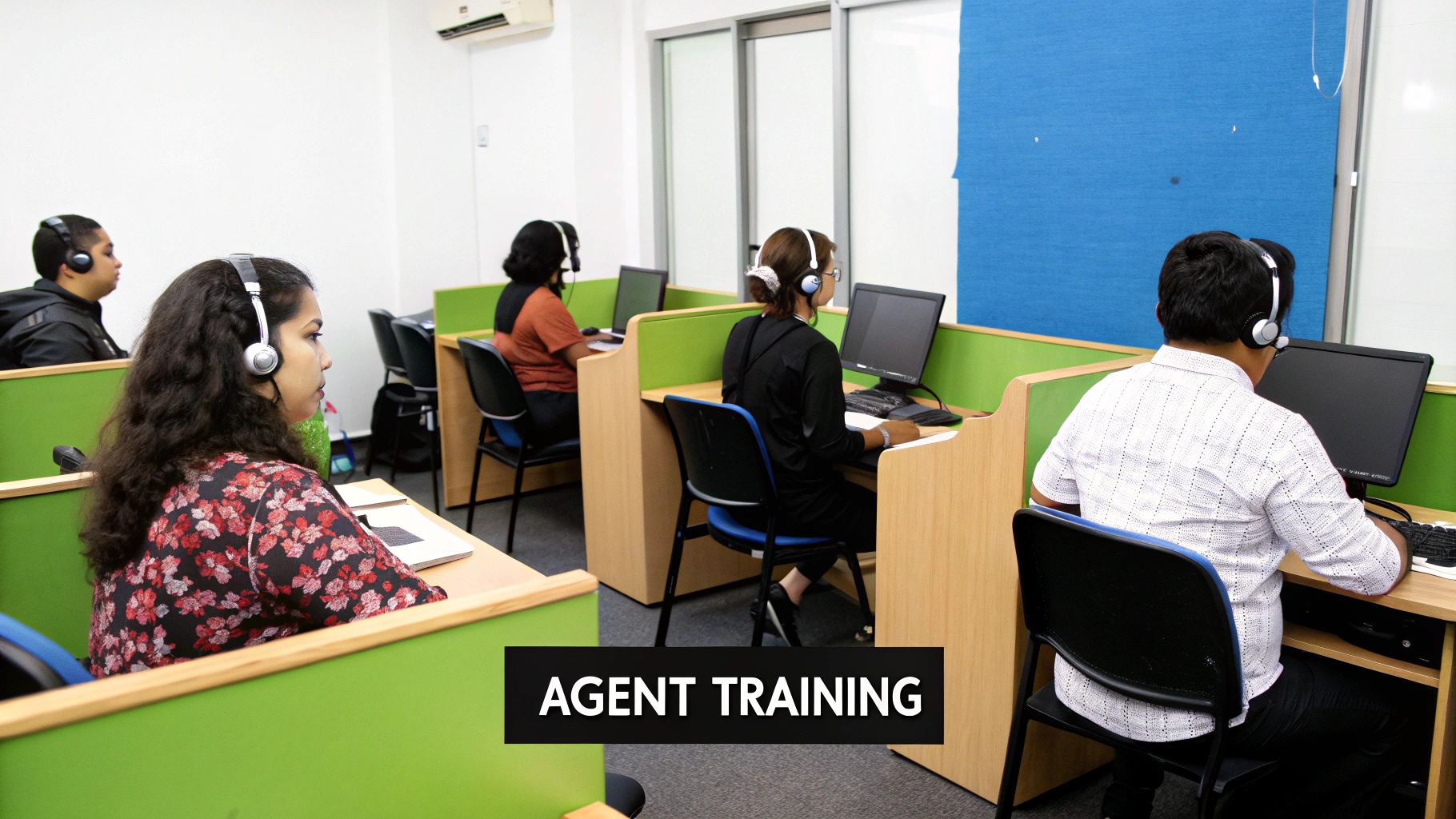
This screenshot from NICE showcases their workforce optimization solutions. Notice the emphasis on performance management and employee engagement – critical for agent retention and motivation. The platform recognizes that optimizing agent performance is intrinsically linked to understanding and meeting their needs. This human-centric approach is key to sustainable call center optimization.
Workforce Planning: Balancing Efficiency and Well-being
Effective workforce planning is like conducting an orchestra. You need the right number of musicians at the right time, playing in harmony. It's a delicate balance between operational efficiency and employee well-being. Having enough agents to handle peak calls without overwhelming individuals is crucial for preventing burnout and high turnover. Imagine a busy restaurant: too few servers and everyone gets stressed; too many, and they’re idle.
Think about offering flexible scheduling to accommodate agents’ lives. Remote work options, flexible shifts, and compressed workweeks can drastically improve job satisfaction and reduce attrition. This broader approach also widens your talent pool, attracting skilled individuals unavailable for traditional 9-to-5 roles.
Training and Development: Investing in Growth
Just as athletes constantly train, call center agents need ongoing development. This goes beyond product updates. Training in communication, conflict resolution, and emotional intelligence equips agents to handle difficult customers with empathy, turning negative interactions positive.
Clear career paths within the call center also motivate agents to invest in themselves. Opportunities for advancement, specialized training, and leadership development create a culture of continuous improvement, benefiting individual agents and strengthening the entire team, leading to better service and higher customer satisfaction.
Measuring and Improving the Agent Experience
How do you know what’s working? You need to measure agent experience as diligently as you measure customer satisfaction. Regular surveys, focus groups, and one-on-one discussions help you understand what's effective, what's not, and where to improve. It boils down to listening to your team and acting on their feedback.
Open communication builds trust and a sense of ownership. Valued and heard agents are more engaged and committed to the call center's success. This positive cycle translates directly into better customer interactions and improved business outcomes. It's a win-win.
To help illustrate how to build this kind of sustainable agent engagement, let's take a look at a framework for workforce optimization.
To visualize a structured approach, consider the following framework:
Workforce Optimization Strategy Framework
A detailed breakdown of key workforce optimization components and their impact on agent performance and customer satisfaction
| Optimization Area | Key Components | Implementation Timeline | Expected ROI |
|---|---|---|---|
| Workforce Planning | Flexible scheduling, Demand forecasting, Skill-based routing | Ongoing/Quarterly Review | Reduced agent turnover, improved service levels |
| Training & Development | Communication skills training, Product knowledge updates, Leadership development programs | Ongoing/Annual Review | Increased agent engagement, improved customer satisfaction |
| Agent Experience Measurement | Regular surveys, Focus groups, Performance reviews | Ongoing/Bi-Annual Review | Improved agent morale, reduced attrition rates |
This table summarizes key areas and components for a comprehensive workforce optimization strategy. By focusing on these elements, you can build a more engaged, satisfied, and high-performing call center team. Remember, investing in your agents is investing in the success of your call center.
Mastering Remote Operations Without Losing Quality
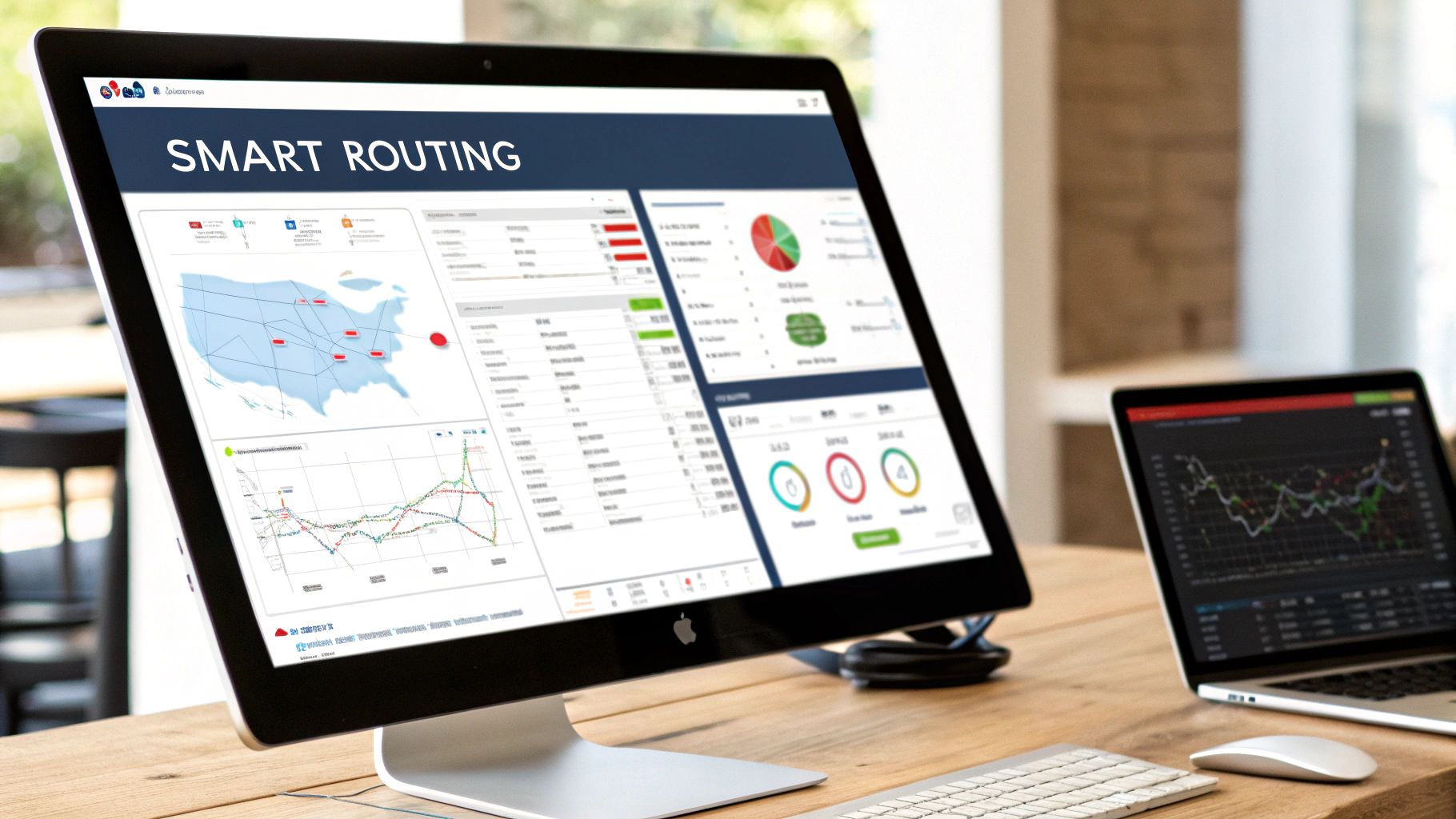
This screenshot from Amazon Connect, a cloud-based contact center solution, shows just how accessible and streamlined remote call center interfaces can be. Essential features like real-time metrics and agent management tools are all there, readily available in a single dashboard. This makes remote supervision much simpler and empowers agents to handle customer interactions effectively, no matter where they are.
Think of it this way: shifting to remote operations isn't just about adopting new tech. It's about fundamentally rethinking how we deliver great service. Imagine a conductor leading an orchestra, but the musicians are scattered across different locations instead of sharing a concert hall. That’s the challenge and the opportunity of managing a remote call center. Coordination, communication, and maintaining a sense of unity become absolutely essential.
Maintaining Team Cohesion Across Distances
One of the biggest hurdles in remote work is keeping the camaraderie and team spirit that usually thrives in a shared office space. But smart managers are getting creative in fostering connections. Think virtual coffee breaks, online team-building activities, and regular check-in calls that go beyond work updates.
These kinds of initiatives help maintain a sense of community and combat the isolation that can sometimes creep in with remote work. Prioritizing employee well-being is crucial for building effective remote teams. If you're interested in learning more, check out these resources on mental health in the workplace.
Ensuring Consistent Training in a Distributed Environment
Training remote teams requires a shift away from traditional classroom settings. Think interactive online modules, virtual role-playing scenarios, and easily accessible online resources. These tools ensure training consistency, regardless of where an agent is located.
Using cloud-based learning management systems (LMS) also allows managers to track agent progress, pinpoint areas for improvement, and tailor training programs to individual needs. For a deeper dive into the evolving landscape of call centers, you might find this interesting: The Impact of Using Omnichannels in Contemporary Call Centres.
Monitoring Performance in a Virtual World
Just like a conductor monitors each section of their orchestra, managers need clear visibility into individual agent performance in a remote environment. This means using cloud-based platforms that provide real-time performance dashboards, call recording and analysis tools, and ways to gather agent feedback.
This data-driven approach offers valuable insights into agent strengths and weaknesses, allowing for targeted coaching and support. For example, if an agent is struggling with a specific type of customer question, managers can offer personalized training and resources to help them improve.
The COVID-19 pandemic significantly sped up the shift to remote work and digital customer interactions, especially in the Middle East. Contact center as a service (CCaaS) has become a necessity for businesses adapting to this new environment. The Middle East CCaaS market is expected to jump from $479.3 million in 2025 to $1,122.9 million by 2032, showing a CAGR of 12.9%. You can find more details about the Middle East CCaaS market here. This growth really highlights the increasing importance of call center optimization for building and strengthening customer relationships in our rapidly changing world.
Embracing the Advantages of Remote Operations
Successfully going remote isn't about trying to recreate a physical call center in a virtual space. It's about recognizing and making the most of the unique benefits that remote work provides. These benefits include access to a broader talent pool, increased flexibility for agents, and potentially substantial cost savings. By tackling the challenges head-on and leveraging the advantages, businesses can turn their call centers into agile, efficient, and customer-focused operations, even with a distributed workforce.
Learning From Centers That Got It Right
Let's face it, sometimes the best way to learn is by looking at what others have done, especially when it comes to something as complex as call center optimization. Think of it like baking a cake – you could follow a recipe blindly, or you could learn from a seasoned baker who's already mastered the perfect rise and frosting swirl. Examining the successes and failures of other call centers gives you that experienced baker's insight.
We'll explore real-world examples of organizations that turned their call center operations around, going from struggling to thriving. We'll focus on the specific choices they made that led to their improvements.
Deconstructing Success: A Look Inside Winning Strategies
These aren't just feel-good success stories. They provide a realistic view of the ups and downs that come with any significant change. You'll see how different companies tackled similar challenges, sometimes with surprisingly inventive solutions.
For instance, consider the challenge of maintaining team unity in a remote or hybrid work environment. Some call centers have found creative ways to foster connection, like implementing virtual memorial options for teams spread across different locations. You can explore more about these kinds of solutions in the Digital Funeral article.
Through conversations with operations managers, we’ll delve into the specific hurdles they faced during implementation and the tactics they used to overcome them. This gives you a practical roadmap of what to expect on your own optimization journey.
This screenshot from the Wikipedia page on Customer Service shows the various ways customers interact with a business:
The image highlights that customer service isn't just confined to the call center. It encompasses every single interaction a customer has with your brand. Optimizing your call center plays a crucial role in shaping the overall customer experience across these different channels.
Identifying Patterns of Success
By studying several case studies, we can start to see common themes emerge among successful optimization initiatives. These recurring patterns reveal the fundamental principles behind long-term positive change. What sets apart the changes that stick from the ones that fizzle out? We'll address this essential question and uncover the key ingredients for lasting transformation.
Anticipating and Overcoming Challenges
No optimization process is ever completely smooth sailing. There will always be bumps along the way. These case studies offer valuable lessons in predicting potential problems and developing strategies to deal with them effectively. We'll discuss how to be prepared for the unexpected, adapt to changing customer needs, and keep your optimization efforts moving forward, even when facing setbacks. Learning from the mistakes of others is one of the smartest ways to avoid making the same mistakes yourself.
Creating Your Personal Optimization Action Plan
Ready to turn your call center into a customer loyalty and revenue powerhouse? Let's map out a practical, personalized plan. Forget generic tips – we're talking actionable strategies based on what's worked for successful operations leaders in the AE region.
This infographic shows how call center optimization works in a cycle:
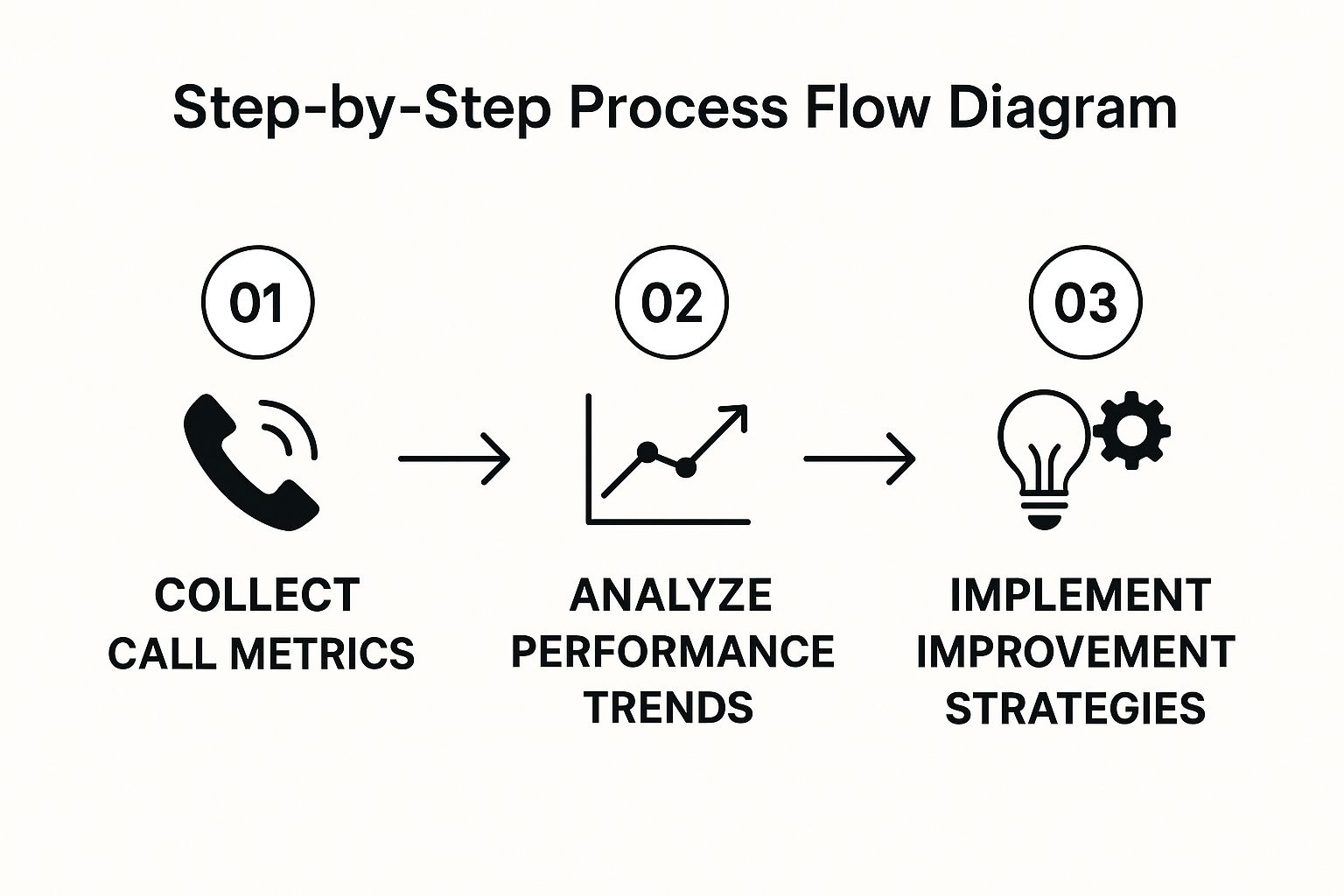
Think of it like a constant loop: collect data, analyze what's happening, and make improvements. This iterative approach means optimization is an ongoing journey, not a one-time fix. This way, you can keep up with changing customer needs and stay ahead of the curve.
Assessing Your Current State
Before making changes, you need to know where you stand. It's like a doctor diagnosing a patient – you need to understand the symptoms before prescribing treatment. Analyze key metrics like average handle time (AHT), first call resolution (FCR), customer satisfaction (CSAT), and agent turnover. What are your biggest pain points? Long wait times? Low FCR? High agent attrition? Identifying these challenges gives you a clear starting point.
This screenshot from Zendesk shows their call center software in action:

Notice how everything is in one place for the agent? Having customer info, past interactions, and different communication channels all together lets agents provide faster, more personalized service, boosting FCR and CSAT.
Identifying High-Impact Opportunities
Once you've diagnosed the issues, focus on the areas with the biggest potential for improvement. It’s like focusing your marketing on the channels that bring in the most leads. If long wait times are killing you, maybe a callback system or a better IVR is the answer. High agent turnover? Focus on training and making your agents happy.
Sequencing Improvements for Maximum Results
Don't try to fix everything at once. That’s like trying to learn five languages at the same time – it’s overwhelming! Break your plan into phases. Tackle the most urgent problem first, then move on to the next. This phased approach lets you implement changes, measure the impact, and adjust as needed, ensuring every change contributes to the bigger picture.
Building a Trackable Action Plan
Your action plan should be specific, measurable, achievable, relevant, and time-bound (SMART). It's like planning a road trip – you wouldn't just say "I want to travel," right? You'd pick a destination, plan the route, set dates, and book places to stay. Your call center plan should be just as detailed, outlining specific milestones, realistic timelines, and how you'll measure success for each phase. This keeps your team focused and accountable.
To help you visualize this, here’s an example framework:
To help you structure your implementation, take a look at this sample timeline:
Call Center Optimization Implementation Timeline
| Phase | Timeline | Key Activities | Success Metrics | Resource Requirements |
|---|---|---|---|---|
| Phase 1: Improve First Call Resolution | Q1 2024 | Implement knowledge base, Train agents on troubleshooting | Increase FCR by 15% | Budget for training materials, Knowledge base software |
| Phase 2: Reduce Average Handle Time | Q2 2024 | Streamline call scripts, Implement screen-pop with customer information | Reduce AHT by 10% | CRM integration, Updated call scripts |
| Phase 3: Enhance Agent Satisfaction | Q3 2024 | Implement flexible scheduling, Conduct agent satisfaction surveys | Increase agent satisfaction by 20% | HR system updates, Survey platform |
This table connects activities to their expected outcomes. By breaking down the process, you make each goal more achievable, building momentum towards a truly transformed call center. Remember, this is just a template – adapt it to your own situation and priorities.
Transform your customer experience and optimize your operations with Cloud Move. Our tailored cloud contact center solutions empower your agents and delight your customers. Explore our solutions and book a free demo today!
